A Teaching Yarn: Helping Kids Connect Learning
A MiddleWeb Blog
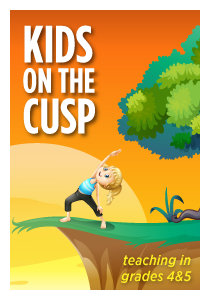 There is incredible value in teaching students to make connections. Students’ success in making these connections is essential to learning, but this is impossible to assess on a broad scale.
There is incredible value in teaching students to make connections. Students’ success in making these connections is essential to learning, but this is impossible to assess on a broad scale.
The science of connections
Since the 1950s and ‘60s, brain science shows us that the connections we make are stored, processed, and retained in various parts of our brain. Other fields of study show us that different brains learn in different ways and explore the science of making interpersonal connections.
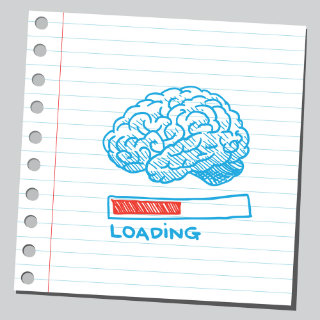 I’m not an expert in any of these fields. I’m a teacher. Part of my training in the 1990s did involve studying education theory. We were taught how to look at our teaching objectives and lesson designs in a way that would accommodate individual learners in a whole-class environment and to create lessons that would pique individual student interest.
I’m not an expert in any of these fields. I’m a teacher. Part of my training in the 1990s did involve studying education theory. We were taught how to look at our teaching objectives and lesson designs in a way that would accommodate individual learners in a whole-class environment and to create lessons that would pique individual student interest.
The difference between learning styles and multiple intelligences is still a bit vague, but I know what I see in the classroom, and there is great satisfaction in designing and planning for my “job” as a teacher. (Take a look at Howard Gardner: ‘Multiple intelligences’ are not ‘learning styles’ and Integrating Learning Styles and Multiple Intelligences by Harvey Silver, Richard Strong and Matthew Perini on kinesthetic intelligence in an interpersonal way.)
Assessing kids’ connections
When I’m doing it, I’m not thinking consciously about whether each child in front of me is being “catered to” via his or her particular learning style. Howard Gardner’s ideas and theories aren’t floating around in my head either. I just present material in as many different ways as I can think of, and pay attention to who is (or isn’t) making the connection.
I don’t know how to “formally assess” how well kids are making these connections on a national or statewide level. I don’t really think it is possible to do this. The two just can’t connect (well, at least not effectively or accurately).
What part does PARCC play?
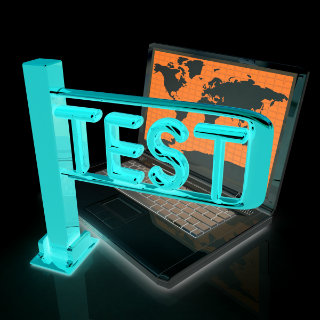 We will complete our first year of PARCC testing this week by taking the last portion of the Language and Literacy Unit. This is meant to assess students’ ability to read, comprehend, make connections, and write about them.
We will complete our first year of PARCC testing this week by taking the last portion of the Language and Literacy Unit. This is meant to assess students’ ability to read, comprehend, make connections, and write about them.
To prepare my kids for this portion, I taught them all year about reading, writing, and making connections. Before the actual test, I showed them the features of the online testing and we went through a few sample passages together as a class. I gave them some to complete independently as well, and I modeled on-demand writing by allowing them to choose a writing prompt for me to respond to on our interactive white board while they watched.
The use of these sample passages was not for “real teaching.” It was simply a way to get the kids familiar with a test format and perhaps ease any stress they might be feeling.
A year’s worth of connecting in the classroom
I’m not concerned about how well they will perform. I know how much progress each student has made. They’re my kids.
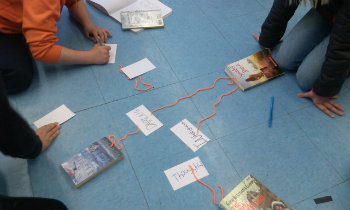 I won’t be able to assess what connections they write about in answer to the on-demand prompts they are given on the PARCC test questions or prompts. I don’t really want to (except out of sheer curiosity).
I won’t be able to assess what connections they write about in answer to the on-demand prompts they are given on the PARCC test questions or prompts. I don’t really want to (except out of sheer curiosity).
I have a way that is much more effective. I work with them all year, applying what I do know about learning styles and multiple intelligences. Their writing shows that this approach seems to be working.
I was trained well in graduate school, but the real teacher learning happened in the classroom. That’s where the genuine connections are made. That’s where real assessment takes place too.
Modeling connections kids can see
My most effective methods for teaching connections are simple. Sometimes all it takes is a little bit of yarn.
One of the best times of day comes right after lunch and recess. Reading aloud each day with my crew gathered on the rug calms them down. At times the reading can stir their souls (especially if you give an Oscar-worthy performance and use really good voices!). Teaching them fluency and how to use punctuation can be as simple as that. It’s twenty minutes well spent, for reasons that are innumerable.
The kids can hear my voice, my tone, my inflection…my emotion. They can watch me make my own connections. They have no idea that they are learning. They are too busy making connections of their own. They can see how the characters touch me, as I make my own interpersonal associations and share them.
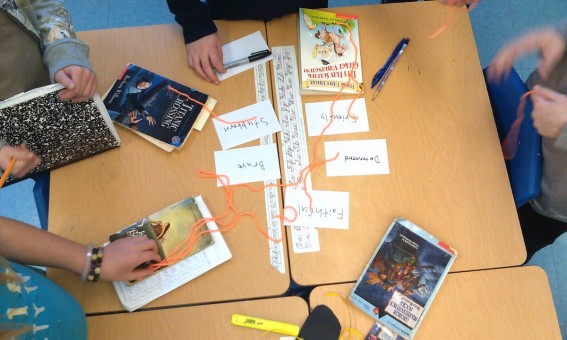 Literal connections with yarn
Literal connections with yarn
This year, we have also “touched” the characters and the stories with a simple activity using only the books they are reading and a ball of yarn.
After seeing this “quick idea” presented at an inservice, I began putting it to work, letting the kids make “literal connections” between novels, characters, settings, and authors. This activity has been an incredible tool for tying together reading, writing, and the art of discussion.
Here are the Read-Alouds we met this year as tools for making these important connections (with and without yarn):
- The Classroom at the End of the Hall by Douglas Evans. This is the first book we read. Each chapter is a story about one student (and their troublesome character traits) in the classroom “at the end of the hall.” There were many early wisdoms to explore as we set the tone for the year.
- Wonder by R.J. Palacio. The kids’ reaction to this powerful novel is difficult to put into words.
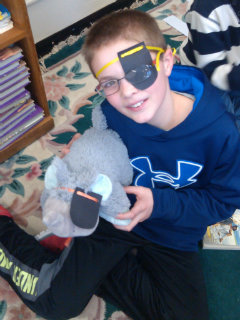 Riding Freedom by Pam Munoz Ryan. Don’t tell the kids she’s a real person until you read the Author’s Note. It’s a little surprise to tweak the genre of Historical Fiction. Having the kids wear eye-patches after reading the chapter where our protagonist loses her vision is a good way to “feel” true empathy (we used yarn to tie them on!).
Riding Freedom by Pam Munoz Ryan. Don’t tell the kids she’s a real person until you read the Author’s Note. It’s a little surprise to tweak the genre of Historical Fiction. Having the kids wear eye-patches after reading the chapter where our protagonist loses her vision is a good way to “feel” true empathy (we used yarn to tie them on!).- The One and Only Ivan by Katherine Applegate. This trailer speaks for itself. “Being a gorilla is not as easy as it looks.” We adopted our first class pet this year. Her name is Stella. Here’s a shot of her with one of our crew. He made her an eyepatch during Riding Freedom, so she could empathize with the rest of us.
- Wonder by R.J. Palacio. We read it again. (Adding in the new “Julian Chapter” let us revisit 1st and 3rd person perspective.)
- The Invention of Hugo Cabret by Brian Selznick. Viewing and imagining a story using “Write-Alouds.”
- Out of My Mind by Sharon M. Draper – We are reading this right now (just to read it and discuss Melody, her story, and the connections we are making).
These books, these characters, these stories of love, loss, friendship, hope, and moving forward through hardship have made it easy for me to teach my kids about making connections. The improvement in their writing was just one of the additional perks.
The questionable link between testing and writing
The only connection I really seem to be having trouble making is the one about why it is a good idea to assess my kids’ writing development and progress with a standardized test. There may be a connection here, but I don’t think it’s a good one.
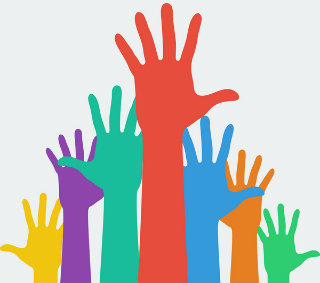 There will never be an accurate assessment of my students’ writing if corporate America and politically motivated policy makers continue to force-feed us broad scale methods of assessing written expression and the sharing of ideas.
There will never be an accurate assessment of my students’ writing if corporate America and politically motivated policy makers continue to force-feed us broad scale methods of assessing written expression and the sharing of ideas.
My students have made incredible strides this year, both as individuals and as developing writers. I have qualitative proof of that. It’s in their Readers and Writers Notebooks. It’s in their attitude about writing…and it’s in their eyes, as they stretch out their arms in excitement, hoping to have the chance to share their connections with the rest of us.
Sometimes a simple ball of yarn can go a long way.

































